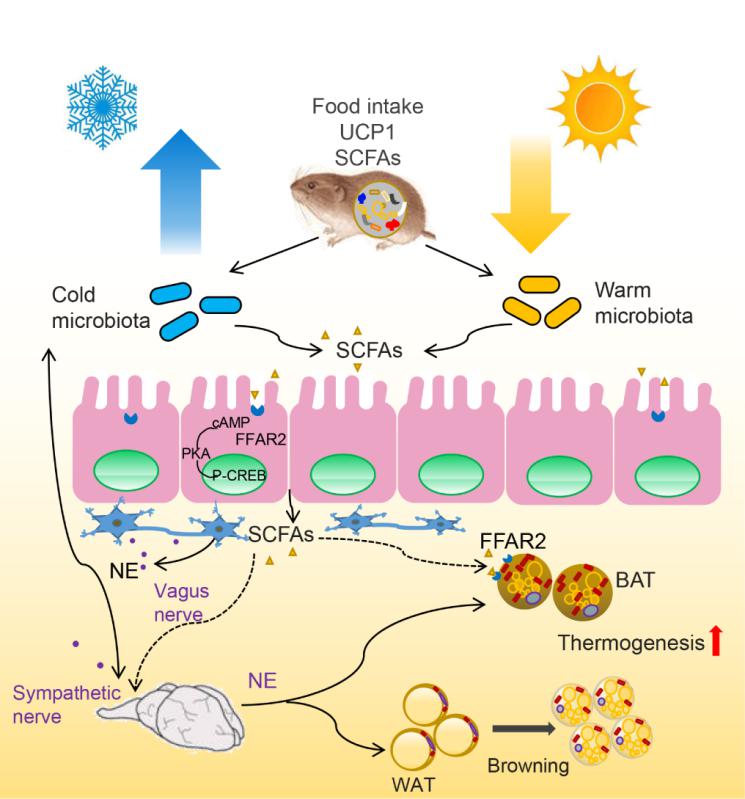Surviving in the harsh winter is an extreme challenge to the non-hibernating small mammals living in northern temperate area. Mammals, as homoeothermic animals, will cost much to maintain relatively stable and high body temperature (around 37oC). Non-shivering thermogenesis generated in brown adipose tissue (BAT) and controlled by sympathetic nervous system, is a rapid and efficient thermogenesis and plays a critical role in body temperature regulation in small mammals (including hibernating mammals). When animals were exposed to cold, the secretion of norepinephrine (NE) from sympathetic fibers distributing in BAT, is increased to activate the intracellular cAMP-PKA-pCREB signaling pathway. This leads to further increased expression of uncoupling protein 1 (UCP1), a unique thermogenic protein localized in the mitochondrial inner membrane of BAT, and increased capacity of NST. Are the commensal bacterial communities involved in thermoregulation of animal hosts?
Prof. De-Hua Wang’s team from the Institute of Zoology, Chinese Academy of Sciences, recently published a paper titled “The microbiota-gut-brain interaction in regulating host metabolic adaptation to cold in male Brandt’s voles (Lasiopodomys brandtii)” in the ISME Journal. The systematic findings illustrated that microbiota-gut-brain interaction mediated mammal metabolic and thermal regulation in cold.
The authors first found that the increases in food intake and thermogenesis were associated with the increases in monoamine neurotransmitters, short-chain fatty acids and altered caecal microbiota during cold acclimation. Through the pair-feeding experiment, they identified that cold temperature can alter the caecal microbiota independently of overfeeding. What’s the function of altered gut microbiota? Whether and how do they regulate the host thermogenesis? Using caecal microbiota transplant along with β3-adrenoceptor antagonism and PKA inhibition, they further confirmed that transplant of cold-acclimated microbiota increased thermogenesis through activation of cAMP-PKA-pCREB signaling. In addition, based on the theory of negative feedback regulation and via NE manipulation, they verified that the increase in NE had a long-term regulatory role in altering gut microbiota structure. These findings demonstrate that gut microbiota-NE crosstalk via cAMP signaling regulates host metabolic and thermal adaptation to cold. It sheds a new light on the mechanisms of communication between the host and microbial symbionts used to improve the survival of small mammals in seasonal environments.
Bo TB#, Zhang XY#*, Wen Jing, Deng K, Qin XW, Wang DH*. 2019. The microbiota-gut-brain interaction in regulating host metabolic adaptation to cold in male Brandt’s voles (Lasiopodomys brandtii). ISME Journal. DOI: 10.1038/s41396-019-0492-y
Website:
https://www.nature.com/articles/s41396-019-0492-y
https://rdcu.be/bPEi7

Figure 1 Working model of the crosstalk between gut microbiota and norepinephrine (NE) via cAMP signaling pathway in mediating host energetics and thermogenesis during cold acclimation

